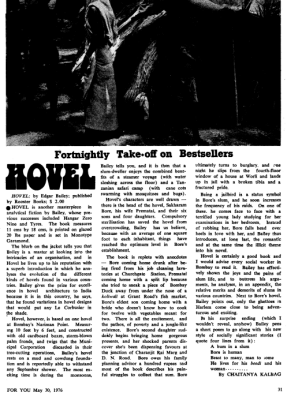Fortnightly Take- off on Bestsellers : Hovel
Published date: For You, May 30th - Jun 12th 1976
HOVEL is another masterpiece in analytical fiction by Bailey, whose previous successes included Hangar Zero Nine and Tyres. The book measures 11 cms by 18 cms, is printed on glazed 20 Ibs paper and is set in Monotype Garamond.
The blurb on the jacket tells you that Bailey is a master at looking into the intricacies of an organisation, and in Hovel he lives up to his reputation with a superb introduction in which he analyses the evolution of the different kinds of hovels found in various countries. Bailey gives the prize for excellence in hovel architecture to India because it is in this country, he says, that he found variations in hovel designs that would put any Le Corbusier in the shade.
Hovel, however, is based on one hovel at Bombay’s Nariman Point. Measuring 10 feet by 6 feet, and constructed with old cardboard boxes, storm-blown palm fronds, and twigs that the Municipal Corporation discarded in their tree-cutting operations, Bailey’s hovel rests on a mud and cowdung foundation and is reportedly able to withstand any September shower. The most ex- citing time is during the monsoons, Bailey tells you, and it is then that a slum-dweller enjoys the combined bene- fits of a steamer voyage (with water sloshing across the floor) and a Tanzanian safari camp (with cane cots swarming with mosquitoes and bugs). Hovel’s characters are well drawn – there is the head of the hovel, Sakharam Bore, his wife Prematai, and their six sons and four daughters. Compulsory sterilisation has saved the hovel from overcrowding, Bailey has us believe, because with an average of one square foot to each inhabitant, things have reached the optimum level in Bore’s establishment.
The book is replete with anecdotes – Bore coming home drunk after being fired from his job cleaning lavatories at Churchgate Station, Prematar coming home with a split lip because she tried to sneak a piece of Bombay Duck away from under the nose of a koliwali at Grant Road’s fish market, Bore’s eldest son coming home with a bride who doesn’t know how to cook for twelve with vegetables meant for two. There is all the excitement, and the pathos, of poverty and a jungle-like existence. Bore’s second daughter suddenly begins bringing home gorgeous presents, and her shocked parents discover she’s been dispensing favours at the junction of Charanjit Rai Marg and D. N. Road. Bore owes his family planning advisor a hundred rupees atid most of the book describes his painful struggles to collect that sum.
Bore ultimately turns to burglary, and one night he slips from the fourth-floor window of a house at Worli and lands up in jail with a broken tibia and a fractured pride.
Being a jailbird is a status symbol in Bore’s slum, and he soon increases the frequency of his raids. On one of these. he comes face to face with a terrified young lady studying for her examinations in her bedroom. Instead of robbing her, Bore falls head over heels in love with her, and Bailey thus introduces, at long last, the romantic and at the same time the illicit theme into his novel.
Hovel is certainly a good book and I would advise every social worker in Bombay to read it. Bailey has effectively shown the joys and the pains of slum life, and to buttress his arguments, he analyses, in an appendix, the relative merits and demerits of slums in various countries. Next to Bore’s hovel, Bailey points out, only the ghettoes in Harlem come close to being adventurous and exciting.
In his surprise ending (which I wouldn’t reveal, anyhow) Bailey pens a short poem to go along with his new style of socially significant stories (I quote four lines from it) :
A bum in a slum Bore is human Beast to many, man to some He lives for his beedi and his woman …






